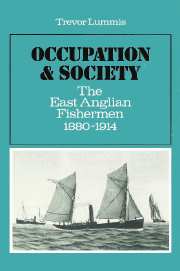Book contents
- Frontmatter
- Contents
- List of figures and tables
- Acknowledgements
- Map
- Introduction
- PART ONE OCCUPATIONAL STRUCTURE
- Introduction
- 1 Inshore
- 2 Trawling
- 3 Drifting
- 4 Working relationships
- PART TWO THE SOCIAL STRUCTURE
- PART THREE THE FAMILY, SOCIAL PRACTICE AND BELIEF
- Appendix: supplementary information on the interviews
- Glossary
- Notes
- Bibliography and sources
- Index
- Frontmatter
- Contents
- List of figures and tables
- Acknowledgements
- Map
- Introduction
- PART ONE OCCUPATIONAL STRUCTURE
- Introduction
- 1 Inshore
- 2 Trawling
- 3 Drifting
- 4 Working relationships
- PART TWO THE SOCIAL STRUCTURE
- PART THREE THE FAMILY, SOCIAL PRACTICE AND BELIEF
- Appendix: supplementary information on the interviews
- Glossary
- Notes
- Bibliography and sources
- Index
Summary
Method, location and development
In value and renown the herring takes an unassailable position as lord of the fishes.
Walter Wood 1911Various forms of driftnet have been used for centuries. They hang stationary in the water like a curtain; fish are captured because as they swim along they strike the net, the mesh of which is wide enough to admit their heads but too narrow to permit their whole bodies to pass through; they cannot back out because the string of the mesh closes behind their gills and traps them. The net is suspended from a series of buoys and has corks along its upper edge and can be adjusted to float a given distance below the surface.
The net itself was traditionally made of hemp twine and the introduction, first in Scotland, of a machine-made net of fine cotton mesh had a dramatic impact on the efficiency of the drifters:
The substitution of cotton for hemp nets may be said to have revolutionised the fishery. A boat that used to carry 960 yards of netting, now carries 3,300 yards. The nets used to be 6 or 7 yards, they are now 10 yards deep. They used to present a catching surface of 3,300 square yards, they now present a catching surface of 33,000 square yards; without increasing the weight of nets to be worked each boat has increased its catching power fivefold.
- Type
- Chapter
- Information
- Occupation and SocietyThe East Anglian Fishermen 1880-1914, pp. 36 - 49Publisher: Cambridge University PressPrint publication year: 1985



